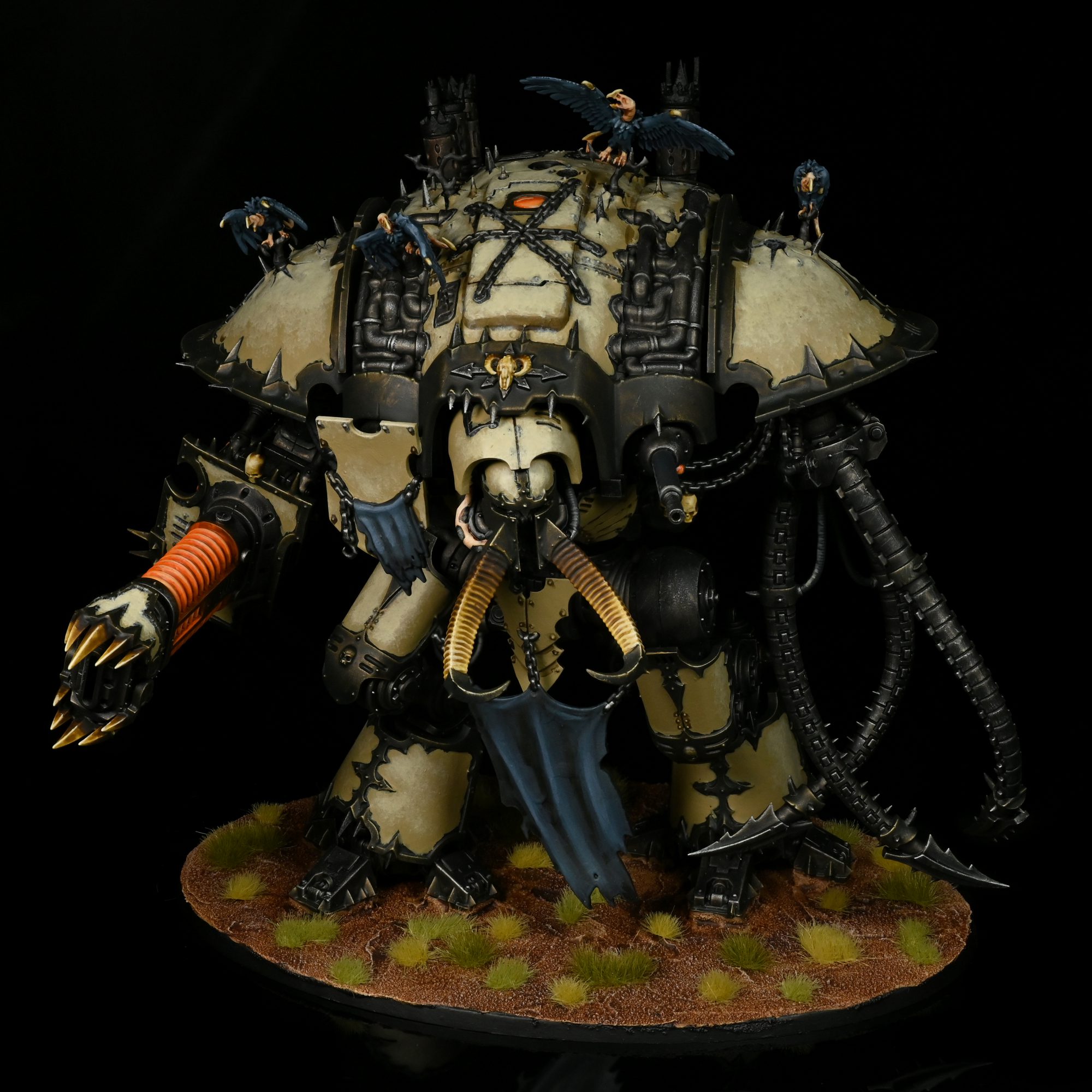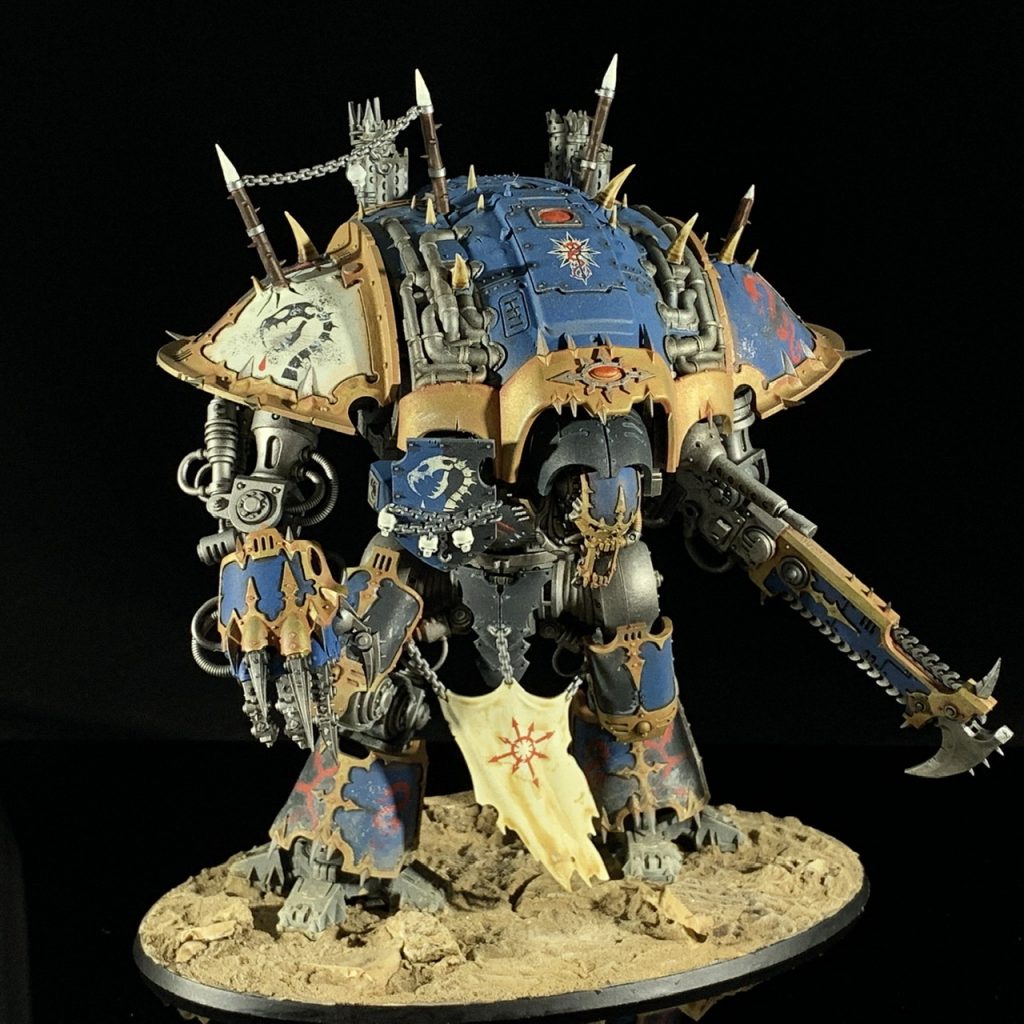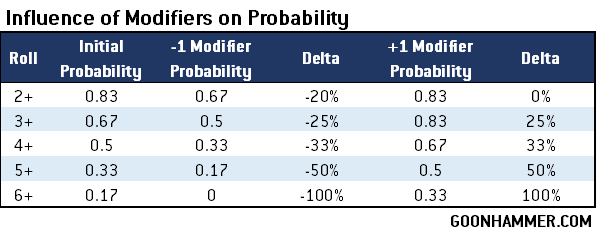Following up on last week’s analysis of loyalist Knights and their Armiger enhancements, this week’s Hammer of Math embraces the Warp and checks out the abilities of the Chaos Knights.
One of the coolest things that Games Workshop has done recently is place a major emphasis on making factions appear distinct. A key part of this is in the use of turn-based abilities like the Canticles of the Omnissiah for the Adeptus Mechanicus and Synaptic Imperatives for Tyranids. We see a similar emphasis within the newly released Codex: Imperial Knights and Codex: Chaos Knights. Where the Imperial Knights are all about chivalric deeds and coordinating bonuses between the Questoris and Armiger units, Chaos Knights are all about spreading the glory of Chaos and quite literally darkening the skies with their presence. A Chaos Knight is a terrifying, unholy abomination which can make even the most stalwart of loyalists question their faith, and to reflect this on the battlefield Chaos Knights have access to the Harbingers of Dread ability. These abilities are a series of area effect (initial range 12″) powers which can do everything from affect ObSec and Aura abilities to modify hit rolls and increase the number of models that flee from a failed Morale test.
To use the Harbingers of Dread ability the Chaos player selects from a list of available abilities at the start of each battle round. The selections are limited based on two factors; the current round and what option was selected previously. Each ability applies for the duration of the battle, meaning that the effects are cumulative. The chart below shows what options are available from each column within each round. For example, in round 3 you chose Empyric Fugue from the Despair Column the in round 4 you could only choose Paralyzing Insanity or Wailing Gheists. In round 1 you will always choose Dread Host and in round 5 Horror of the Warp is the only option.
House Korvax have a particularly nasty Household Bond called Forged in Terror which, once per battle, allows them to pick a Harbinger ability corresponding to the current or any previous round and make it active for the entire army. Any Chaos Knight player can also use Doom and Despair for 2 CP in the third, fourth, or fifth round to select a Harbinger ability from a previous round and make it active so long as the player’s Warlord is on the battlefield.

Portents of Doom
The Doom column primarily focuses on affecting Leadership and Combat Attrition tests. While normally Leadership modifications are considered a bit of a joke, several Dread abilities test off of Leadership on a 2d6 where exceeding the highest Leadership characteristic in the unit causes the test to pass. The impact of even minor modifications is significant, particularly when it comes to the center of the curve around Ld 6 through 8.
Should you stay on the Doom track the impact on Leadership can be significant.
- Dread Host is automatically applied in the first round and subtracts 1 from Leadership and Combat Attrition tests.
- Encroaching Doom increases the Dread range of every model by 25%.
- Mortal Terror causes an additional model to flee when the Morale test is failed, or an additional D3 models if the Morale test is at least twice the highest Leadership characteristic.
- Wailing Gheists causes the unit to subtract an addition 2 from the Leadership characteristic for a net of -3 with Dread Host).
- Horror of the Warp is automatically applied in the 5th round and affects Combat Attrition tests. You subtract 1 from Combat Attrition tests (for a net of -2 with Dread Host) and on an unmodified roll of 1 2 models flee instead of 1.
A cumulative -3 penalty will take a typical Ld 8 unit from a 28% chance of passing the Dread test to a 72% and means even a single casualty will cause a failed Morale Test 1 in 3 times. By turn 5 even full strength units are losing half of their models to Combat Attrition tests (assuming they aren’t Astartes), and against smaller units the effects of Mortal Terror can be particularly devastating.

Harbingers of Despair
The Despair column is purely focused on altering the abilities of opponents, and as a result the impact is far less numbers based.
- Creeping Dismay reduces both Aura abilities and any abilities used in the Command phase by 3″, which can do anything from prevent a Space Marine Techmarine from using Awaken the Machine Spirit or an Apothecary from using Narthecium to reduce the range of Imperial Knight Bondsman abilities by 25%.
- Empyric Fugue affects Actions by forcing multiple Dread tests (once when a unit wants to start an Action, and again in the Morale phase if the unit is currently performing the action). If the Dread test is failed then the action also fails.
- Paralyzing Insanity simply strips away Objective Secured from any unit within Dread range, which is particularly brutal when combined with the fact that all War Dog units gain Objective Secured.
Omens of Darkness
The Darkness column is primarily focused on affecting the ability of enemy units to attack, either by modifying hit rolls or altering target selection and charges.
- Gheist Storm has multiple effects in different phases. While an enemy is within Dread range (which is either 12″ or 15″ if Encroaching Doom is active) then the enemy must pass a Dread test when they are selected to shoot or declare a charge. In the case of shooting they cannot make ranged attacks unless they shoot the closest eligible target or the closest CHAOS KNIGHTS target. In the case of charges if they fail the Dread Test then any charge rolls made for the unit are halved. To put that into context if they fail the Dread test then the enemy unit has to be within 3″ of the target to have a better than average chance of making the charge.
- Pall of Darkness and Veil of Shadows have similar effects where they subtract 1 from the hit roll of different attacks. In the case of Pall of Darkness it’s -1 to hit rolls for ranged attacks more than 12″ away, and for Veil of Shadows it applies to all melee attacks. These are the only two abilities which do not rely on Dread range or Dread tests; any attack against the unit is modified. We’ve covered the impact of modifiers several times before, so consult the helpful chart below.

Be Afraid, Be Very Afraid
I love the combination of flexibility and brutal impact that these new abilities bring to the table, and the difference between Chaos and Imperial Knights couldn’t be more stark. Players have the option to carefully tailor their approach to the enemy, which does a good job of eliminating feelsbad moments where major portions of your army’s power is rendered irrelevant on a technicality (say… Deathwatch facing anyone human). On top of that these abilities are effective, especially when stacked and properly leveraged. The lore consistently talks about the despair and terror associated with facing Chaos, and it’s nice to see that reflected on the tabletop.
Thanks for reading! If you have any questions or comments feel free to drop us a note in the Comments below or email us at contact@goonhammer.com. That’s also the best way to suggest topics for future articles.





